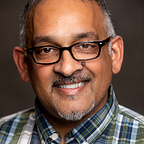Mathematical Wellness is a Ludicrous Fantasy: Which is The Best Place for Me to End Writing Books!
The fantasy cover look of the book was intentional. Calming forest. Wildflowers. A girl chasing a rabbit. A colorful prism floating in the just below the title — where a magical castle might be in some mythic fable. All of it is explained in the book — even the crystal, whose powers are mathematically literal and metaphorical.
In 2013, I hated the math in education so much, that I quit. Do you know how much you have to hate something — and I love math — to quit a great job with great benefits?? A lot. That hate needs to seep right down into the very fabric of your identity. Your own mental and emotional health has to be at risk from witnessing mathematics get treated with such political polish and myopic purpose and functioning — rented mules are treated better.
This book isn’t intended to function in this world of toxic performance values, competition, selfishness, and enabling the current real world to exist.
The current real world sucks. Billionaires having space races while the planet burns, starves, and physically, morally, and spiritually. I had zero intention of writing a math book to enable the education world I left. I had full intention of writing one in a world that I could only imagine.
Throw in a pandemic, and all of the above pillars of wellness are in urgent need of repair. As much as I like to believe mathematics is important, my idea of wellness will not come if society and education demand that we teach through a growing lens of kindness, grace, humility, empathy, and love.
The mathematics that I talk about for wellness is NOT fuzzy. In fact, it is much more challenging and complex than the mathematics in school. However, unlike school math, I am primarily interested in students and teachers spending time in the messy middle of these problems than get fixated on an overvalued final answer. I am not the only who has been interested in this is cloudy and confusing center of mathematics.
It’s been the quiet narrative of the history of mathematics. It’s just never been truly installed. It came close 50 years ago, when the romance period of learning(discussed in the book) as ascribed by Alfred North Whitehead was indulged. The best textbooks and math problems came from that era.
Yesterday, I went to see Roadrunner, the documentary about Anthony Bourdain. As I mention in the book, I have been a fan of his for 20 years. Saw every episode of all shows. Read his books. Even met in 2005.
Watching the documentary, mostly with welled eyes, was the grieving I never properly did 3 years ago. I intellectualized his passing with this article, but the runaway emotional expression of it occurred yesterday.
While many scenes hit me with sucker punches to the gut, the line that Bourdain was a searcher for ambiguity struck me hard. Not the searcher part. So many of us are searchers. It was the ambiguity part. The messy middle. To latch onto neither pole of supposed truth and wallow, sometimes in anguish, in that unheralded, vague area of uncertainty.
Considering my book is more or less an homage to the math’s messy and unheralded middle. It’s also where you find all the pillars for mathematical wellness — social, emotional, mental, and spiritual. I found that reflection in the movie to be affirming and poignant as to how I chose to write my final book.
What else could you write about after writing a romantic ode to healing the world with mathematics — the same thing that gives millions of students unhealthy anxiety(and poor sense of self/lacking identity/etc.)?
Nothing! Even my enthusiastic proclamation should alert to to the fact that I am happy and over the moon with all of this.
Mathematics, beautifully abstract, in its purest form, is fantasy. Now it just needs a world to adopt it. This book is advocate for finding that world…
